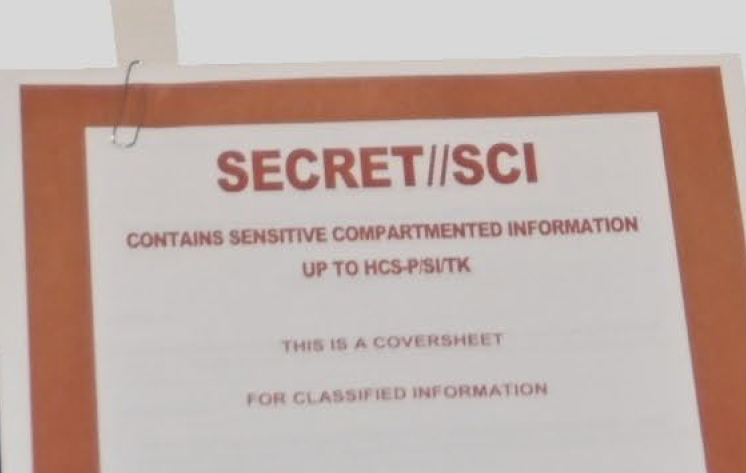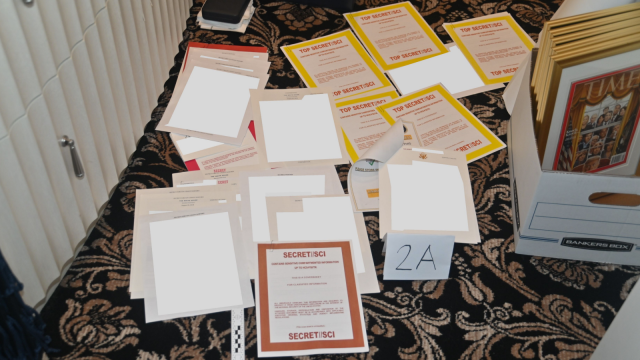The first thing you notice is the hideous carpet. You could probably spill a whole pot of coffee on it and no one would notice. Next you’re wondering what that weird handle on the wall is for.
It almost looks like a film still. Like Clint Eastwood might be standing there, looking down at some ransacked office, about to say something incredibly obvious.
“They must’ve been looking for something.”
On the floor, there’s six piles of paperclip-bound documents. One has a red cover sheet labelled “SECRET”. Five others, yellow, are labelled “TOP SECRET”. Below them, a smattering of loose sheets with various other markings: “LIMITED ACCESS,” “CONFIDENTIAL”.
At first, it looks like someone carefully placed white copy paper over all the important text. But no, on closer inspection, it’s all been digitally excised. Still, the lines are very deliberate, and there’s several more words left purposely untouched: “SECRET,” “WASHINGTON,” “THE WHITE HOUSE.”
And there’s a date: “August 28, 2018″.

The implication is clear: These are the kinds of documents that people only transport in locked briefcases, probably under armed guard. They’re read in soundproof rooms shielded from radio waves and other electromagnetic radiation. This photograph shouldn’t even exist. These documents were never meant for that gauche carpet.
Officially “Attachment F”, the photograph is one of six exhibits accompanying a motion filed by the Justice Department on Tuesday. If you thought the Mar-a-Lago document scandal couldn’t get any worse for Donald Trump, you were wrong. The motion lays out a timeline that essentially shatters any remaining presumption of good-faith on the part of Team Trump. The government now seems fairly convinced that someone tried to hide and steal these documents.
In response to a subpoena, Trump’s lawyers met with three federal agents and a DOJ lawyer at Mar-a-Lago on June 3, more than a month before the FBI raid, the filing says. The agents were informed that the remainder of the missing White House documents were confined to a single storage room on the estate. When they left, the agents took only one envelope containing 38 documents — the result of, purportedly, a “diligent search” carried out in advance of their visit.
Seventeen of those documents were marked top secret, another 16 secret, and five confidential. Trump’s attorneys offered no explanation, the DOJ says, for why they weren’t included in the 15 boxes Trump originally surrendered to the National Archives in January.
After the visit, the government developed evidence, it says, that even more classified material had been “concealed and removed” from the storage room ahead of their arrival on June 3. “[E]fforts were likely taken,” it says, “to obstruct the government’s investigation.”
For obvious reasons, the probable cause obtained by the government under the Espionage Act has gotten most of the attention. But the punishment for obstruction is actually twice as severe: up to 20 years in prison.
But wait, there’s more: When the FBI did finally raid the estate on Aug. 8, they discovered “twice the amount” of classified material on the premises as they had before — including in the storage room, which they’d already searched. Seventy-six documents bearing classified markings were discovered in the room, along with those in the photograph, which were found in Trump’s office.

The documents in the photograph contain a series of specific markings known as “handling caveats.” Whatever information they contain, having a top secret clearance alone isn’t enough to grant you access. The designation “HCS-P”, for example, is one given to information that, in the wrong hands, could put the life or lives of confidential sources at risk. The marking “SI” refers to information related to electronic surveillance generally carried out by the National Security Agency. Another marking, “TK,” stands for “Talent Keyhole,” a system that keeps secrets about U.S. spy satellites — many if not all of them nuclear-powered.
These developments, the DOJ now says, have called into “serious question” the former president’s cooperation in the whole matter.
The motion if filed Tuesday was in opposition to a request by Trump’s attorneys to appoint a “special master” to review the seized materials and help set aside any documents protected by attorney-client privilege. The DOJ is arguing that Trump’s request lacks any legal standing, if only because he has no individual right to any of documents; all of which it says are covered under the President Records Act.
It did, however, acknowledge a few “personal effects” had been seized in the raid. But those were “commingled,” it says, in containers holding all this classified material.
As far as the government’s concerned, that means it’s evidence.
A full version of the FBI’s photograph is below. Click here to read entire motion. Or here to just view its attachments.

